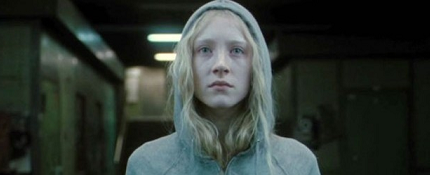Stay tuned throughout September for nuttiness and zaniness of all varieties - click here for the full lineup, and click here for prior entries (which won't do you much good today, what with this being the first - madness!).
 Insincere, arrogant and self-serving reporter Johnny Barrett (Peter Breck) is hungry to win a Pulitzer Prize—and he’s convinced he’s found his ticket to winning the coveted journalistic trophy by revealing the mystery behind the unsolved murder of a patient inside a mental hospital. With the encouragement of his editor “Swanee” Swanson (Bill Zuckert) and coaching from psychiatrist pal Dr. Fong (Philip Ahn), Barrett will convince the authorities that he needs to be committed to that same hospital—by having his stripper girlfriend Cathy (Constance Towers) pose as his “sister” and accuse him of making incestuous advances toward her.
Insincere, arrogant and self-serving reporter Johnny Barrett (Peter Breck) is hungry to win a Pulitzer Prize—and he’s convinced he’s found his ticket to winning the coveted journalistic trophy by revealing the mystery behind the unsolved murder of a patient inside a mental hospital. With the encouragement of his editor “Swanee” Swanson (Bill Zuckert) and coaching from psychiatrist pal Dr. Fong (Philip Ahn), Barrett will convince the authorities that he needs to be committed to that same hospital—by having his stripper girlfriend Cathy (Constance Towers) pose as his “sister” and accuse him of making incestuous advances toward her. Barrett completely snows Dr. Menkin (Paul Dubov) into thinking he’s off his trolley, and he gets the fifty-cent tour of the institution from an attendant named Wilkes (Chuck Roberson) after receiving initial hostility from another attendant (John Craig) who answers to “Lloyd”—and who, interestingly enough, is the only employee in the asylum who suspects that Barrett isn’t on the up-and-up (“Born phonies, all your newspapermen”). The “tour” culminates with Wilkes showing Barrett a corridor in the hospital known as “the street,” where model patients are allowed to meet-and-greet with one another. It is here that Barrett finds the first of three witnesses to the murder of the inmate (a man named Sloan)—a shell-shocked P.O.W. named Stuart (James Best). Serving a hitch in Korea, Stuart turned turncoat and defected to the Communist side…upon his return, however, he cracked from the strain of the disgrace and now believes himself to be Confederate Army General Jeb Stuart. Barrat gains Stuart’s confidence (by posing as General Nathan Bedford Forrest) but is only able to learn that Sloan’s killer wore white pants before Stuart slips back into insanity.
Barrett completely snows Dr. Menkin (Paul Dubov) into thinking he’s off his trolley, and he gets the fifty-cent tour of the institution from an attendant named Wilkes (Chuck Roberson) after receiving initial hostility from another attendant (John Craig) who answers to “Lloyd”—and who, interestingly enough, is the only employee in the asylum who suspects that Barrett isn’t on the up-and-up (“Born phonies, all your newspapermen”). The “tour” culminates with Wilkes showing Barrett a corridor in the hospital known as “the street,” where model patients are allowed to meet-and-greet with one another. It is here that Barrett finds the first of three witnesses to the murder of the inmate (a man named Sloan)—a shell-shocked P.O.W. named Stuart (James Best). Serving a hitch in Korea, Stuart turned turncoat and defected to the Communist side…upon his return, however, he cracked from the strain of the disgrace and now believes himself to be Confederate Army General Jeb Stuart. Barrat gains Stuart’s confidence (by posing as General Nathan Bedford Forrest) but is only able to learn that Sloan’s killer wore white pants before Stuart slips back into insanity. The second witness to the murder is a college student named Trent (Hari Rhodes), who as a “guinea pig” had been enrolled in an all-white university…but because he was unable to handle the pressures of both his forced celebrity and integration, has convinced himself that he’s white and a member of the KKK. Trent starts a “race riot” in the “street” and both he and Barrett are strait-jacketed and assigned to side-by-side beds; awakening from a nightmare, Trent experiences a moment of lucidity and is able to tell Johnny the circumstances behind his breakdown. But upon asking the $64 question—“Who killed Sloan in the kitchen?”—Barrett unwittingly returns Trent back to his mentally deranged state, with the student shouting racist slogans at the top of his lungs.
The second witness to the murder is a college student named Trent (Hari Rhodes), who as a “guinea pig” had been enrolled in an all-white university…but because he was unable to handle the pressures of both his forced celebrity and integration, has convinced himself that he’s white and a member of the KKK. Trent starts a “race riot” in the “street” and both he and Barrett are strait-jacketed and assigned to side-by-side beds; awakening from a nightmare, Trent experiences a moment of lucidity and is able to tell Johnny the circumstances behind his breakdown. But upon asking the $64 question—“Who killed Sloan in the kitchen?”—Barrett unwittingly returns Trent back to his mentally deranged state, with the student shouting racist slogans at the top of his lungs. By the time Barrett is able to approach the third witness—a nuclear physicist named Boden (Gene Evans) whose mind has reverted to that of a six-year-old—his hospital stay has started to take a toll on his own fragile mental state. He’s victimized by a 300-pound patient (Larry Tucker) named Pagliacci (who sings opera arias and forces Johnny to chew gum), attacked by patients in the section of the hospital set aside for females (colloquially known as the “Nympho Ward”) and subjected to electroshock therapy. His isolation from Cathy, who was vehemently against Barrett’s unorthodox plan from the get-go, is also beginning to take its toll as he fantasizes about her being unfaithful to him. When Cathy pays him a visit and welcomes him with a soulful kiss on the lips, he becomes violent and admonishes her to never do that again—he’s starting to believe his own “sickness”!
By the time Barrett is able to approach the third witness—a nuclear physicist named Boden (Gene Evans) whose mind has reverted to that of a six-year-old—his hospital stay has started to take a toll on his own fragile mental state. He’s victimized by a 300-pound patient (Larry Tucker) named Pagliacci (who sings opera arias and forces Johnny to chew gum), attacked by patients in the section of the hospital set aside for females (colloquially known as the “Nympho Ward”) and subjected to electroshock therapy. His isolation from Cathy, who was vehemently against Barrett’s unorthodox plan from the get-go, is also beginning to take its toll as he fantasizes about her being unfaithful to him. When Cathy pays him a visit and welcomes him with a soulful kiss on the lips, he becomes violent and admonishes her to never do that again—he’s starting to believe his own “sickness”! Barrett finally learns the identity of Sloan’s killer from Boden who, like Stuart and Trent, temporarily finds his moment of clarity. Barrett writes his story and is a shoo-in to win that Pulitzer…but at a terrible cost: he’s become a catatonic schizophrenic and must remain incarcerated in the “shock corridor.”
Barrett finally learns the identity of Sloan’s killer from Boden who, like Stuart and Trent, temporarily finds his moment of clarity. Barrett writes his story and is a shoo-in to win that Pulitzer…but at a terrible cost: he’s become a catatonic schizophrenic and must remain incarcerated in the “shock corridor.”The first lesson movie buffs will learn after watching a Samuel Fuller film for the first time is that the writer-director-producer of seventeen films (all of them low-budget) between 1949 and 1965 did not do nuance. His in-your-face style of filmmaking, which stemmed from his earlier careers as a newspaperman (on the crime beat), infantryman, novelist and screenwriter, often concentrated on lurid and sensationalistic subject matter that provided a masterful disguise for often serious themes addressing controversial social/political issues and meditations on the human condition.
 Fuller made westerns (Forty Guns, Run of the Arrow), war films (The Steel Helmet, China Gate) and crime films (Pickup on South Street, Underworld U.S.A.)—all of which showcase sudden, energetic outbursts of violence, flesh-and-blood characters drawn in shades of amoral gray, and recurring thorny subtexts such as sexism and racism. Shock Corridor is in many ways the culmination of all his films—a deservedly popular cult item that walks the thinnest line between great art and pulpy trash. Shot in ten days by Fuller on one set with no exteriors, it’s filmed like the demented dream of someone who’s lost their marbles…with color footage (shot by the director himself while he made House of Bamboo and for another movie that never got made) inserted at random moments during the film that makes no sense. But there was—if you’ll pardon the pun—a method to Sam’s madness; he utilized the services of ace cinematographer Stanley Cortez, whose striking photography is able to lift the tabloid-like material to loftier heights. (Cortez had the idea to photograph midgets at the end of the set to make the corridor appear longer than it actually was.)
Fuller made westerns (Forty Guns, Run of the Arrow), war films (The Steel Helmet, China Gate) and crime films (Pickup on South Street, Underworld U.S.A.)—all of which showcase sudden, energetic outbursts of violence, flesh-and-blood characters drawn in shades of amoral gray, and recurring thorny subtexts such as sexism and racism. Shock Corridor is in many ways the culmination of all his films—a deservedly popular cult item that walks the thinnest line between great art and pulpy trash. Shot in ten days by Fuller on one set with no exteriors, it’s filmed like the demented dream of someone who’s lost their marbles…with color footage (shot by the director himself while he made House of Bamboo and for another movie that never got made) inserted at random moments during the film that makes no sense. But there was—if you’ll pardon the pun—a method to Sam’s madness; he utilized the services of ace cinematographer Stanley Cortez, whose striking photography is able to lift the tabloid-like material to loftier heights. (Cortez had the idea to photograph midgets at the end of the set to make the corridor appear longer than it actually was.) What makes Corridor both so fascinating and frustrating is that the dialogue of the film’s characters is so frequently stilted and embarrassing—and yet, like the moments of lucidity experienced by those individuals in the movie who have been classified as insane, every so often a kernel of truth is uttered…an incidence of something absolutely brave and honest that was completely foreign to anything in the American cinema at that time. Fuller trowels it on thick: the sexual sensationalism includes a tantalizing strip-tease by Towers’ character (ironically, the only decent personage in the film; the actress plays a similar role in Fuller’s The Naked Kiss, which was released a year later) and the famous attack on Barrett by the sex-starved female patients (“Nymphos!”). (There’s even a mind-blowing sequence in which Barrett imagines that he’s caught in a torrential downpour right smack dab in the hallway, and that he’s being repeatedly struck by lightning.) But it’s all a diversion, or what Martin Scorsese once observed as “smuggling” by the director; Fuller is painting a horrific picture of America as a sad, confused nation where racism, anti-Communism and ramped-up fears of the bomb have replaced rational discourse. Much of the dialogue that emanates from the character played by Rhodes (“There’s one of ‘em now! Let’s get him before he marries my daughter!”) could have come straight out of the mouth of any Southern segregationist…presenting the United States of America as a microcosm set inside an insane asylum is simply subversive genius on Fuller’s part.
What makes Corridor both so fascinating and frustrating is that the dialogue of the film’s characters is so frequently stilted and embarrassing—and yet, like the moments of lucidity experienced by those individuals in the movie who have been classified as insane, every so often a kernel of truth is uttered…an incidence of something absolutely brave and honest that was completely foreign to anything in the American cinema at that time. Fuller trowels it on thick: the sexual sensationalism includes a tantalizing strip-tease by Towers’ character (ironically, the only decent personage in the film; the actress plays a similar role in Fuller’s The Naked Kiss, which was released a year later) and the famous attack on Barrett by the sex-starved female patients (“Nymphos!”). (There’s even a mind-blowing sequence in which Barrett imagines that he’s caught in a torrential downpour right smack dab in the hallway, and that he’s being repeatedly struck by lightning.) But it’s all a diversion, or what Martin Scorsese once observed as “smuggling” by the director; Fuller is painting a horrific picture of America as a sad, confused nation where racism, anti-Communism and ramped-up fears of the bomb have replaced rational discourse. Much of the dialogue that emanates from the character played by Rhodes (“There’s one of ‘em now! Let’s get him before he marries my daughter!”) could have come straight out of the mouth of any Southern segregationist…presenting the United States of America as a microcosm set inside an insane asylum is simply subversive genius on Fuller’s part. While Johnny Barrett is the protagonist of Corridor—but he is by no means its “hero.” He is, in fact, a thoroughly dislikable wanker—dishonest and driven to further his own journalistic ends at the expense of others and his own mental health. To my mind, that’s the most interesting and prescient facet of Corridor—it’s as if Fuller had the vision to foresee how today’s “journalists” compromise their integrity by become all-too-cozy with the subjects of their reporting…making themselves the story, in other words. “Ever since my voice changed I wanted to be in the company of journalist greats.” So it’s just desserts that Barrett loses his ability to speak at one point in the film and by its conclusion is, according to the hospital administrator (John Matthews), “an insane mute.” “Life is a messy weapon,” observes patient Pagliacci…but while Shock Corridor is a messy film, it is also an important and unforgettable one.
While Johnny Barrett is the protagonist of Corridor—but he is by no means its “hero.” He is, in fact, a thoroughly dislikable wanker—dishonest and driven to further his own journalistic ends at the expense of others and his own mental health. To my mind, that’s the most interesting and prescient facet of Corridor—it’s as if Fuller had the vision to foresee how today’s “journalists” compromise their integrity by become all-too-cozy with the subjects of their reporting…making themselves the story, in other words. “Ever since my voice changed I wanted to be in the company of journalist greats.” So it’s just desserts that Barrett loses his ability to speak at one point in the film and by its conclusion is, according to the hospital administrator (John Matthews), “an insane mute.” “Life is a messy weapon,” observes patient Pagliacci…but while Shock Corridor is a messy film, it is also an important and unforgettable one.Later today: We'll count to Se7en with Detailed Criticism's Sebastian.


























2 people have chosen wisely: on "30 dAyS oF cRAzY: Shock Corridor"
Hi! Fletch...
What a very interesting and detailed review of a film that I must add to my X-mas list...
...I have watched a couple of director Sam Fuller's films ("House Of Bamboo" and "Scandal Sheet"), but this one I have "missed."
Therefore, I will have to seek this film called "Shock Corridor" out to watch too...I'am quite sure that it's part of Sam Fuller's recently, released box-set collection.
I just checked and it is...
The Sam Fuller Box-Set
Thanks, for sharing!
DeeDee ;-D
The Criterion Collection
Oops! Sam Fuller's "Shock Corridor" was released by Criterion and isn't on the Sony box-set as mentioned above...
my mistake!
Post a Comment